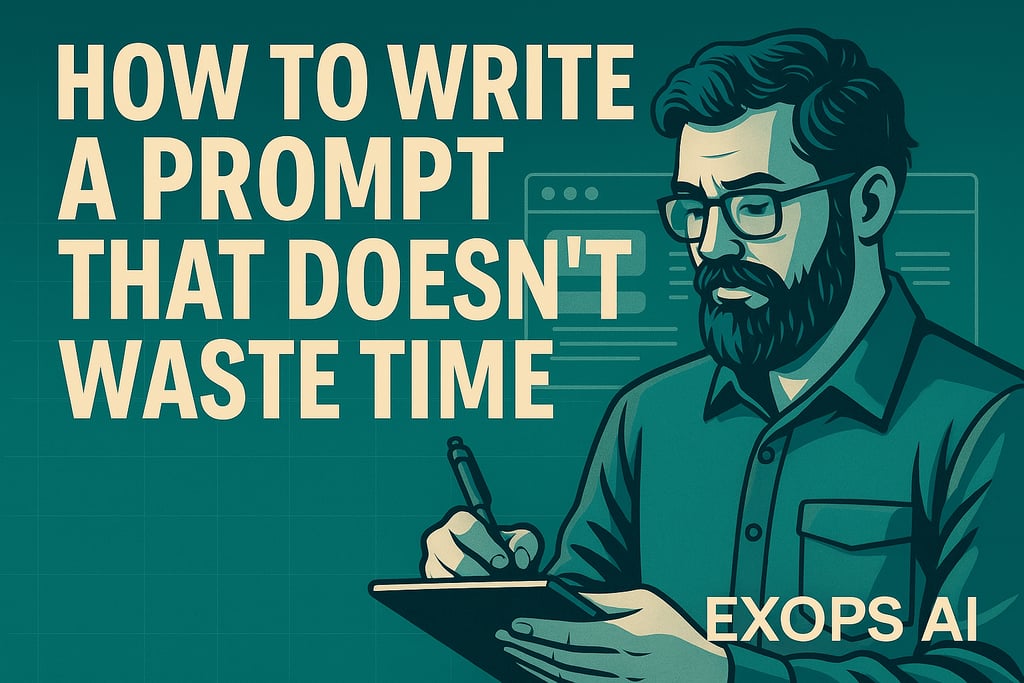
How to Write a Prompt That Doesn’t Waste Time
Good prompts lead to good outputs. This article breaks down how to write effective prompts for GPT tools—especially when time, clarity, and structure matter most. Learn what to include, what to avoid, and how to get results that actually help.
USE OF GENERATIVE AI
EXOPS AI
7/26/20252 min read



If you’ve ever typed a prompt into ChatGPT and gotten something totally off-track, you’re not alone. In industrial environments—where clarity, speed, and safety matter—bad prompts don’t just waste time. They create confusion, missed steps, and rework.
Good prompts aren’t about fancy language or perfect grammar. They’re about giving the AI what it needs to help you solve your problem faster.
Why Prompts Matter in Operations
GPT tools don’t “understand” like humans. They process based on structure, context, and pattern. That means your input needs to tell the tool:
What role you’re in
What task you’re trying to perform
What key details matter most
What format you want back
If you’re vague, the AI fills in the blanks—and often fills them wrong.
Common Prompt Mistakes
Too vague: “Help with this issue”
Missing role or perspective: “Write a checklist” (for whom?)
No variables: “Is this safe?” (What’s the setup?)
Mixed tasks: “Summarize, analyze, and draft something…”
The result? Long, unclear answers that don’t match your need.
Better Prompt Structure = Better Output
Think of prompts like a short field briefing. Who’s involved? What’s the problem? What do you need?
Prompt Anatomy:
Your role – “I’m a safety coordinator…”
The task – “...and I need a closeout summary...”
The data – “...for a chemical spill that happened during line isolation.”
The format – “Can you structure it in bullet points with time stamps?”
Result: A tailored response with the right structure, tone, and logic.
Fast Prompting, Real Use Case
Scenario:
“I’m a maintenance supervisor. We had an unplanned shutdown due to a sensor fault. I need a one-paragraph incident summary and a 3-step mitigation checklist.”
GPT Output:
Summary: [1 paragraph, time/location/context]
Checklist:
Add sensor to routine inspection checklist
Review alarm thresholds
Conduct short training brief with operators
All generated in seconds. No need to start from scratch or email for help.
Tips for Writing Strong Prompts
State your role and what you need
Include numbers, time, and values if available
Say what format you want back (table, bullets, short text, etc.)
Use direct, clean sentences—even in field language
If the output feels wrong, rephrase and be more specific
Conclusion
Prompting well isn’t about being a good writer. It’s about knowing what the AI needs to do its job—and giving it just enough structure to respond effectively.
In high-pressure work, vague inputs cost time. Clear prompts create alignment, save steps, and move the job forward.
Disclaimer
EXOPS AI tools are designed to support trained professionals. They do not replace human oversight, formal procedures, or compliance systems. Always verify outputs before using in critical workflows.
Author: EXOPS AI L.L.C.
Connect with us: info@exopsai.io | +1 (833) 396-7724
Explore our Custom GPT Store: https://exopsai.io/artificial-intelligence-gpt-store

